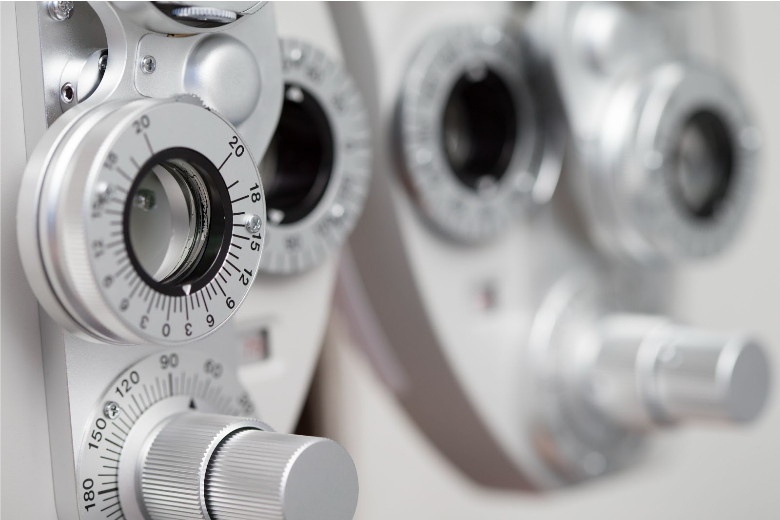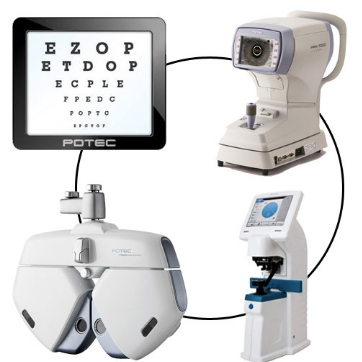
One of the most important pieces of equipment in any exam lane is the phoropter, used to measure refractive error. The device, which resembles a large mechanical mask, is made up of cylinders, prisms, and lenses that enable eye care professionals to determine the ideal prescription strength for patients who wear glasses or contact lenses.
In the past, doctors referred to all refraction systems—both manual and digital—as phoropters. However, thanks to recent advancements in technology and the shift toward digital systems, there are now several key differences between the two. Before we examine those differences and touch on the benefits of digital refraction systems, let's talk briefly about refractive errors.
What are refractive errors?
Put simply, a refractive error is a type of vision problem that causes blurry vision. According to the National Eye Institute, refractive errors are the most common vision problem in the United States, affecting more than 150 million individuals. The different types of refractive errors include:
- Nearsightedness (myopia): Objects far away appear blurry
- Farsightedness (hyperopia): Objects up close appear blurry
- Astigmatism: An imperfection in the curvature of the eye that causes blurred vision
- Presbyopia: Farsightedness that occurs as a result of aging
Though the most common symptom of refractive errors is blurred vision, other symptoms may include double vision, hazy vision, and seeing a glare or halo around bright lights. Secondary symptoms include eye fatigue, trouble focusing, and headaches caused by prolonged squinting or frowning. Because some people may not notice the symptoms of refractive errors right away, routine eye exams are critical to ensure the preservation of optimal vision.
Why do refractive errors happen?
Refractive errors are actually all about light. The retina is an extremely thin layer of nerve cells that sits in the back of the eye, near the optic nerve. When light passes through the eye and lands on the retina, it sends a message to the brain (via the optic nerve) to see and interpret the images in front of us.
In people with perfect focus (20/20 vision), light will hit the retina at one single point, like a bullseye. But for those with a refractive error, this bullseye is slightly off, causing the light to land either in front of or behind the retina.

In patients who are nearsighted, for example, light rays don't pass all the way through the eye and images are focused in front of—rather than on—the retina, causing them to appear blurry. In patients who are farsighted, light rays pass through the retina and images focus behind it. In these cases, the length of the eyeball is to blame: too long in myopia patients, and too short in hyperopia patients.
With astigmatism, however, it's all about the shape of the eye. Basically, the eyeball should be perfectly round like a basketball, so that when light enters through the cornea it bends evenly. But some eyes are shaped more like a football, so that incoming light bends in different lengths and directions. As a result, things at a distance start to appear blurry and stretched out.
Finally, with presbyopia, the problem is with the lens of the eye. As we age, the lens hardens, which makes it harder for the eye to focus and causes images to become blurry. Normally the eye is flexible enough to change shape, but the natural hardening causes decreased flexibility, making it harder for the eye to focus on objects that are up close.
Diagnosing and correcting refractive errors with a phoropter
The phoropter plays a key role in helping ophthalmic professionals determine a patient's corrective lens prescription. A typical refraction exam with a phoropter involves the following steps:
Sphere: Checking the patient’s sphere is the first step of a refraction exam. Sphere refers to the amount of lens power (measured in diopters) needed to correct nearsightedness (-) or farsightedness (+). If a patient requires a spherical correction, that means the lens strength is equal at every point (meridian) of the eye.
Axis: This step of the exam helps doctors check for astigmatism. While sphere refers to a “blanket” lens that corrects blurred vision in all meridians of the eye, axis refers to the lens meridian that doesn’t require cylinder power to correct astigmatism. Axis is the lens meridian 90 degrees away from the meridian that does require cylinder power.
Cylinder: This indicates the cylinder curve needed to correct astigmatism. Once the axis portion of the exam is complete, the prism is flipped about 45 degrees so that the power marks align with the axis. The doctor can then ask the patient which is better: “one” (minus power) or “two” (plus power).
Finally, the doctor will double check the sphere power and adjust as necessary before determining the final prescription.

A more advanced, efficient system: The digital refractor
The first phoropter was patented in the early 1900s. But like most inventions over time, it has evolved into a more advanced, efficient system: the digital refractor.
In many ways, modern digital refractors are the same as traditional manual phoropters, in that they use the same methods to check and verify a patient’s optical prescription with cylinders, prisms, and lenses. However, digital systems offer far more functionality, which in turn makes refraction exams more streamlined, accurate, and effortless than ever.
From pretest data to the final prescription, doctors no longer have to manually enter data into both the refractor and the patient’s record. Instead, with a digital system, each piece of equipment communicates with the others, so pretest data is automatically sent to the refractor, and all subsequent information is saved directly into the patient’s digital record. This eliminates repetitive entries and makes prescription checks and updates easy and organized.
Suffice to say, in modern-day ophthalmic offices, digital refractors are quickly becoming the equipment standard over manual phoropters, and eye care professionals credit digital refraction equipment with the following benefits.
- Increased efficiency (doctors report seeing 2-6 more patients daily)
- Enhanced capabilities
- High return on investment
- Easy connectivity of equipment
- Improved accuracy, fewer mistakes
- Greater patient satisfaction (thanks to more one-on-one time with doctors)
- Reduced pain and discomfort (due to elimination of repetitive motion)
- Easy integration with EMR
Need help choosing the right phoropter for your practice?
Veatch Ophthalmic Instruments offers a wide variety of both manual phoropters and digital refractors, along with the supplies and accessories necessary to keep your systems functioning optimally.
If you are considering a digital refraction system, we have some of the most competitive prices on the market for state-of-the-art equipment and unmatched service. In fact, our digital refractors are typically half the cost of other systems because we leave out the middle man!
Call Veatch today at (800) 447-7511 or contact us online to learn more.